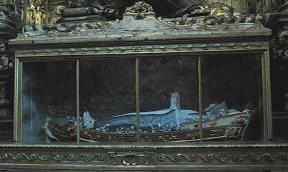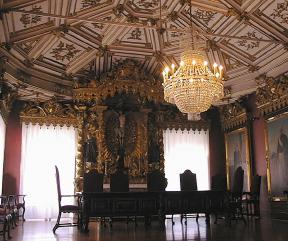
Porto
July 5th - July 8th, 1999

Our path turns south now as we begin to head down the coast. Our first stop in Portugal is Porto, the country's second largest city and major port wine producing region. We found a nice, quiet room off of the seedy downtown waterfront and began to explore how Portugal differs from Spain. In many ways, it turns out, but we left with the impression that Spain and Portugal are like two sisters, sitting with their backs to each other, refusing to acknowledge each others existence.
Sé Cathedral
Towards the center of town is Porto's big cathedral, called the Sé. Plainer on the outside than those we saw in the rest of Europe, the Portuguese trademark blue ceramic tiles (azulejos) grace many of its outside walls. On the inside, we found very ornate gilded wood carvings covering much of the church's interior. However, we found the church much less well maintained than most we've seen in Europe. An example is the bottom right altar: made of solid silver with gold decoration, it looked as if it hadn't been cleaned in fifty years. Add to that smoke damage from a back room fire and the Cathedral exuded a bit of a seedy air.
|
|
|
Igreja de Santa Clara
Much more enjoyable than the Sé, we stumbled upon the church of Santa Clara while trying to find a way up to the top of the old city walls (impossible, it turns out). The interior of the church is completely encased in incredible gilded wood carvings, depicting the trials of Santa Clara and San Francisco. We lingered there for a while, and heard the story of how Santa Clara was locked up in a back room of the church for much of her life.
|
|
Igreja de São Francisco
Our favorite (of course) is the church of São Francisco. We had a special visit as an English choir group was rehearsing at the front of the church as we visited. Very well preserved, the church had some of the most intricate carvings we've seen. A few, were a bit on the gruesome side, as this photo below to the right illustrates as a group of monks prays piously to god as two moors hack their heads off.
|
|
We found in one section of the church an elaborately carved tree. We first thought it was the tree of life, but a local told us it's called the Jesse tree. We're not familiar with the story of Jesse, and no one could elaborate further. Right below the Jesse tree was a statue of Mary in a casket shaped like a boat. There are many such depictions of Jesus in state, but this is the first we saw of Mary and the first using a boat -- an icon in Portuguese lore.
|
 |
The old administrative offices are open to the public as well, and there we found the office of the pastor. Again, it was completely lined with elaborately carved, gilded and painted wood, and was complete with an especially gory Jesus hanging right behind the pastor's desk.

Underneath the church we found an extensive network of tombs: resting places for those waiting Judgment day. Especially interesting is a big chamber below the main floor of tombs full of bones of worshippers too poor or unimportant enough to rate a sarcophagus.
|
|
Port Wineries
Of course the real reason we're here is the wine. Porto is famous for port wines, although port wine is actually a British invention. Seems some enterprising British wine importer added brandy to cheap Portuguese wine in order to keep it from spoiling on the trip to England and liked the result. Now-a-days, port grapes are grown in an arid region of Portugal called the Douro valley in very poor soil, pressed into wine and then mixed with 170 proof brandy. The resulting mixture is then aged in oak barrels for up to fifty years. All port wineries stick to this tried-and-true method, so a tour usually consists of marching around gigantic, musty old warehouses stacked high with barrels, hearing about the wineries commitment to heritage and quality, and then ending with the tasting sessions. On can fill an afternoon of marching around in the hot Portuguese sun with two or three wineries and crash quite contentedly that evening -- trust us.
|
|
Of course, some wineries try to differentiate themselves. Veterans of Napa and Sonoma valleys will find much of it familiar, including the Taylor peacock family (dad, mom and baby chick).
|
|
|
A fascinating port winery to visit is Ferreira. Built up by an enterprising woman in the nineteenth century, she chose the emu as the winery's icon as the emu never walks backward. They give a high quality tour, including showing us the racks of truly old port wine. Some of it dates back as far as 1815, although stuff that old is only for family. However, they will sell the 1863 vintage for a mere $2000/bottle.
We made a few friends at the port tasting at Ferreira. Patricia, a Lisboa native, was showing her Dutch friend Martijn around the country and that (of course) included a trip to Porto and the wineries. She gave us some valuable insights into the Portuguese mindset.
Port Wineries we liked:
An Atlantic Sunset
Oh, and we can't forget to mention the wonderful Atlantic sunset we enjoyed our last night in Porto. Our afternoon/evening was spent on the beach strip on the west side of town -- quite the happening place. After sunset, while waiting for a bus we witnessed a poor older gentleman for whom the day's hot sun had been too much as he had a diabetic seizure. We were heartened by the number of Portuguese who stopped and offered help, with one young woman actually driving him and his friends to the hospital (apparently, he couldn't afford an ambulance). It made us wonder if a similar episode happened in a similar size American city whether as many people would had offered aid.

First impressions of the Portuguese
We really didn't have any preconceived notions of what to expect of Portugal, yet we were still surprised when we got here. In general, the environmental awareness in Europe is a good thirty years behind what it is in the USA, and Portugal was even farther behind than Europe in general. Much of this comes from the fact that Portugal is not a first world country. Even though it was the first and once the largest colonial power in the world, those days are long, long ago and Portugal has not kept pace with its European brethern. Much of the infrastructure was saw was almost third world, including Porto's sewage system. For over a hundred years they've been dumping their untreated sewage into the Rio Duoro. The fish seem to have adapted, holding regular afternoon feeding frenzies at the dump pipe (photo below). The locals claim they don't catch or eat those fish, but at more than one sunset we saw half a dozen or so people fishing for them.

The European Union has been pouring a lot of money into Portugal, updating its infrastructure in preparation for the day when they bring the Portuguese economy in line with the rest of Europe. Much more needs to be done, and the Portuguese are a little apprehensive of it all. They've been their own isolated enclave for some time now, and the union with the greater Europe means they need to open their economy to outsiders. In particular, they fear domination by their much larger neighbor, Spain. This year both the phone and electrical systems get deregulated, and most believe that the Spanish will come in and sweep the existing feeble Portuguese companies away.
We were happy to find that the Portuguese people were very friendly and open to those that didn't speak Portuguese -- quite a contrast to the Spanish who tended to brush you off if you didn't speak their language.